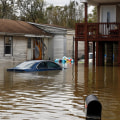The Louisiana State Emergency Operations Plan (EOP) is the structure for organizing and coordinating state resources by area of function. Functions are classified according to the type of support or resource provided or managed within the National Incident Management System (NIMS) and its subcomponent, the Incident Command System (ICS). In addition to the ESF identified within the NIMS structure, Louisiana has included Military Support as an ESF. The Department of Children and Family Services (DCFS) is responsible for managing state shelters for people with critical transportation needs, shelters for people with special medical needs, shelters for sex offenders, and shelters for unaccompanied minors, while providing staff and resources to shelters for the general population who request it.
The magnitude of Hurricane Katrina's destruction presented three immediate challenges to the federal government. Firstly, the enormous amount of destruction in such a large area created an enormous demand for emergency assistance, such as fuel, medical supplies, food, shelter and water. This demand, together with the austere conditions throughout the Gulf Coast following Katrina's arrival ashore, exceeded FEMA's standard disaster capacities and processes. Secondly, the localities needed help to carry out emergency response operations and re-establish control of the incident.
However, the impact of Hurricane Katrina on the Gulf Coast region limited the use of normal mutual aid agreements, which rely on assistance from neighboring cities and counties. In this case, neighboring jurisdictions were overwhelmed on their own and unable to provide assistance elsewhere. Assistance had to come from states outside the region and from the federal government. The requirement for an active federal role in emergency response operations was most pronounced in New Orleans.
Finally, communication problems had a debilitating effect on response efforts in the region and on the national effort in general. Officials, from national leaders to first responders on the ground, lacked the level of knowledge of the situation needed to respond quickly and effectively to the disaster. This was a recipe for an inefficient and ineffective federal response. The division will develop and deliver a training course related to the emergency management responsibilities of officers at the state level and a training course related to the emergency management responsibilities of emergency management officers and coordinators of political branches.
The emergency management council will help the division identify, mobilize and deploy state resources to respond to major emergencies and disasters across the state. The division, in cooperation with the emergency management council, local governments, regional entities, medical and health centers, volunteer groups, private sector partners, the Federal Emergency Management Agency and other federal agencies will develop an annex to the state emergency management plan that addresses initial response planning to provide essential supplies, equipment and services to provide supplies, equipment and essential support services to the population during the first five days immediately following a disaster. All stakeholders understand the role of ESF-8 in CSC incident and how chains of command of state emergency operations center (EOC) and agency's internal operations center coordinate development, communication and implementation of new CSC strategies in response to specific demands of each incident. It is important to note that these specialized protocols are only used when a disaster has been declared, when EMS medical director has authorized their use, when they are included in emergency operations plan of dispatching agency, and when staff have received training and exercise to recognize factors that trigger their activation (National Academies of Emergency Dispatch).
The division will develop a plan in consultation with State Department of Health Services and local government entities that have established emergency management plans to increase capacities of local emergency shelters to provide shelter and care to specialized care populations during a disaster. A representative of state emergency management board agency is selected by emergency management board chair who is not personally liable for civil damages from action that arises from performance of person's duties on board or committee. Each district disaster committee will coordinate with political subdivisions located in disaster district to ensure that state and federal emergency resources are available as needed to provide most efficient and effective response possible.






